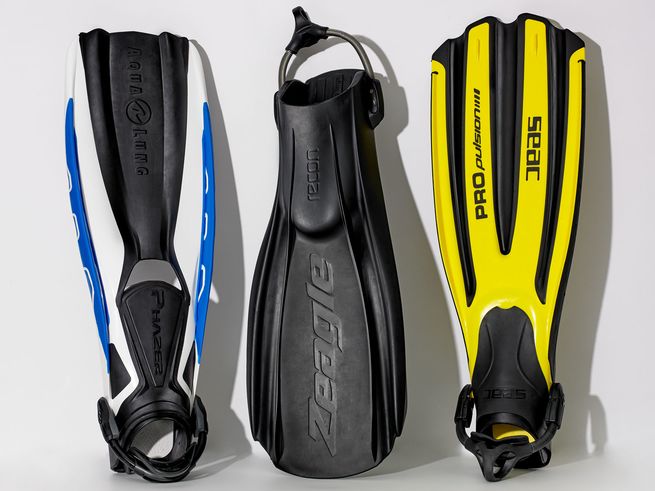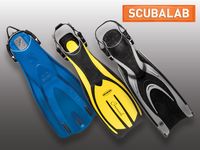Dive Fins
One of the first things you realize underwater is that you’re not getting far without a pair of dive fins. Fins are an essential part of your scuba gear setup, and one of thefirst things you should buy before earning youropen water certification.
Dive fins come in many variations (see below), but are typically made of thermosplastic elastomers, rubber or (more commonly) a combination of the two. The materials used provide different benefits, with rubber typically providing more flexibility and weight. Finding the sweet spot depends on your kicking and diving style. Fins consist of the blade, foot pocket and a buckle-and-strap system if they are open-heel fins.
Want to see the pros and cons of the latest fins on the market? Check out ScubaLab’s 2019 review, where we review the best scuba fins in a head-to-head test
What Are the Different Types of Fins Available to Scuba Divers?
There are many different types of fins for scuba divers, all of which have their pros and cons.
Open-Heel vs. Full-Foot Dive Fins
Open-heel dive fins have a larger foot pocket enclosed by a buckle-and-strap connection or a stretchable cord like a bungee or spring. Open-heel fins allow divers to wear boots with their fins, which is preferable in areas with cold water or shore-diving destinations that require walking out into the surf. These fins are typically heavier and more stiff, which is good for diving in heavier currents.
Full-foot dive fins have an enclosed foot pocket that divers simply slip their feet into. This is typically made out of a stretchy rubber material, or could have a smaller bungee system, like the Scubapro Go model. This is preferred by some divers in tropical destinations, or freedivers and snorkelers. These fins are typically lighter, more flexible and have less drag.
Split vs. Paddle Fins
Split fins slice through the water with minimal resistance, because rather than pushing against the water with brute force, their flexible blades, when engaged in an up-tempo flutter kick, actually generate lift along with a jet-propulsion effect, similar to a boat’s propeller. The faster the propeller turns, the more propulsion is generated. In other words, with split fins, power comes from the speed of a diver’s kick rather than the force of the kick.
However, due to the principles of the design, the best kick for a split fin is a narrow, rapid flutter kick. Not all divers like to employ this kind of kicking action. For them, a paddle fin is probably the better choice.
How Do I Choose the Best Dive Fin?
Choosing the best dive fins comes down to two factors: Your style of diving and your personal preferences. Here are a couple of things to consider:
Where will you be diving?
The water temperature, level of currents and surrounding environment all determine which style of dive fin is best. If you are in tropical water on a shallow reef, lightweight, flexible full-foot fins will work just fine. If you are in a cave or wreck, you will need a shorter fin that works well with a frog kick so you can easily maneuver in tight spaces. If you anticipate heavy current, you need a stiffer fin that allows you to accelerate quickly and swim with power. If you are traveling and have luggage restrictions, you might want a lighter or shorter fin to better fit in your travel bag.
How do you prefer to kick?
Some fins are designed to work better with a frog kick, while others perform best with a flutter kick. Some divers want to have high flexibility and little resistance, creating a faster cadence when they kick, while others want maximum resistance so they can kick less frequently.
Want info on freediving fins? Check out this guide to selecting the best pair of freediving fins.
Cleaning and Maintaining Your Dive Fins
Cleaning your dive fins is pretty simple—give your fins a nice freshwater rinse after your dives to avoid salt buildup or debris from freshwater sites. After dives, inspect the straps and foot pockets to ensure there are no tears or signs or breakage. Avoid storing your fins in awkward positions that could warp the foot pockets or bend the blade. New fins come with foot-pocket inserts—hold onto these and keep them in the foot pockets during storage to maintain the shape of the pockets. Store your fins out of the sun to cracking and discoloration.




